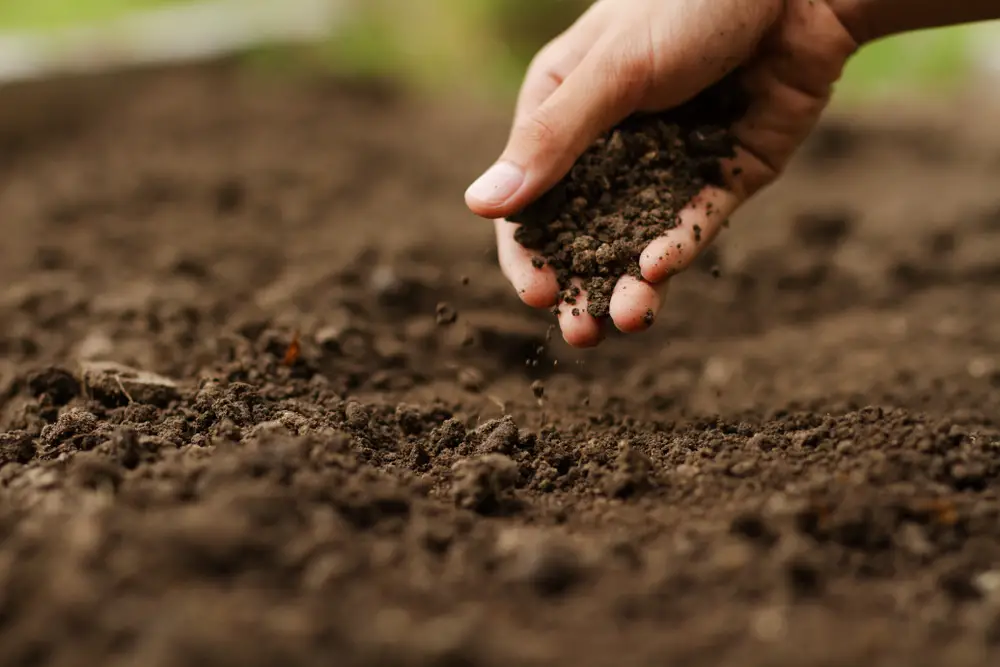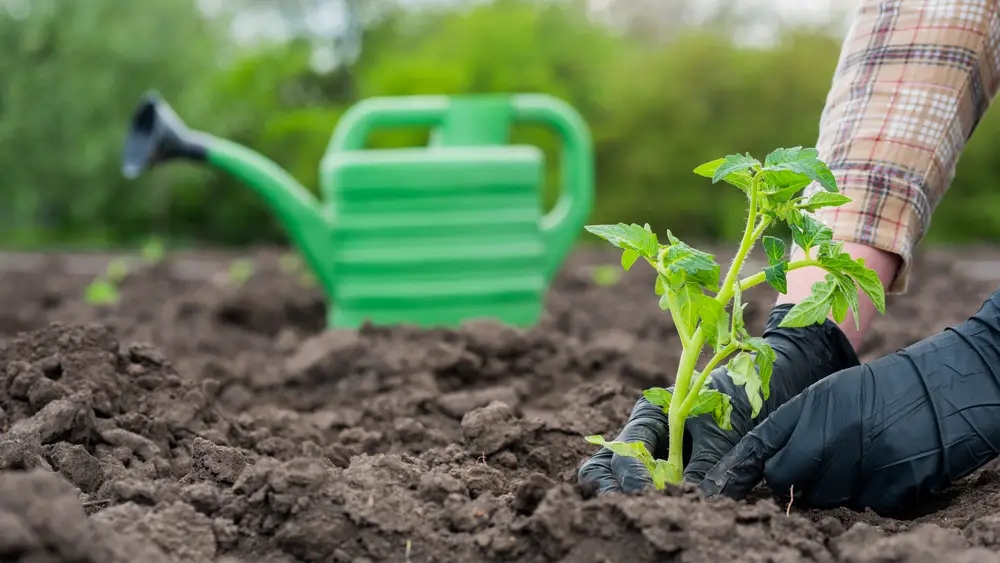Healthy soil is one of the building blocks for healthy plants. When your soil is in excellent condition, you don’t need as many pesticides and fertilizer. But what kind of soil is best for your vegetable garden?
Determining Overall Health of Your Soil

There are seventeen different elements that are essential for proper plant growth. Of these, phosphorus, nitrogen, and potassium are the most vital. They are referred to as macronutrients since plants consume them from the soil in large quantities.
Fertilizers containing all three nutrients are labeled as complete fertilizers, but they may not have everything your soil needs. Sulfur, magnesium, and calcium are secondary nutrients that are also important to plants. Boron, iron, manganese, copper, and zinc are micronutrients or lesser nutrients.
Some micronutrients may contain a specific function, like cobalt. While many plants don’t commonly use cobalt, it will help legumes fix nitrogen. Acid-alkaline balance or pH readings are essential to plant health as well. All these components combined make for healthy soil for a vegetable garden.
Testing Your Soil
How do you know if your soil is healthy or not? Furthermore, why is testing your soil before you prepare it so important? Testing allows you to determine which minerals are abundant in your soil or which ones it may need.
Some places provide affordable soil tests. These companies will measure soil pH, calcium, magnesium, phosphorus, potassium, and nitrogen. Some will report micronutrient content, but not everyone will need this information as they add organic material to their soil. You can also buy a do-it-yourself test, like this Rapitest Soil Test Kit, and conduct your own examination.
Obtaining pH levels for your soil will indicate your plant’s ability to absorb available nutrients. The best pH level for plants is between 6.5 and 6.8. It will allow the plant to absorb minerals and nutrients easily. If your soil tests below 6.0, it is acidic. If it is over 7.0, it is alkaline. In these ranges, it won’t matter how many nutrients are in the soil. Your plant will not be able to absorb them properly.
Soil kits usually include a pH test so homeowners can conduct it themselves. You can also purchase a pH meter, though these may not be as accurate.
The best time to test your soil is in the fall or spring when it’s stable. This time is also best to add organic fertilizer or soil amendments if the soil doesn’t have enough nutrients or minerals.
Soil Type and Texture

You should also examine the soil’s texture before planting a vegetable garden. Soil texture is determined by the amount of clay, silt, and sand it contains. Sand is the most significant part of soil particles. It will feel gritty when you touch it. The second highest concentration found in soil is silt. Silt is powdery when dry and slippery when wet.
The smallest component of soil is clay. Clay is composed of flat pieces and can stack together like plates.
To determine soil texture, pick up a bit in your hands and rub the soil between your fingers. If it feels gritty, then it is sandy. Silty soil feels smooth, like talcum powder. If the soil feels harsh when it is dry and slippery when wet, it is composed of heavy clay. Many soils will fall in between.
Sandy soil is generally nutrient-poor because nutrients and water quickly drain through the large spaces between sand particles. They are usually low in organic matter and microbes that vegetables need to thrive.
Silty soils will not drain well because they are too dense. However, silty soils are more fertile when compared to clay or sandy soils.
Heavy clay soil will be very dense and hard, will crack if dry, and doesn’t offer much drainage. Since there isn’t much space between particles, there isn’t sufficient microbial life or organic matter in the soil. Roots will have a challenging time growing through hard material.
How Can I Choose and Prepare My Soil for Vegetable Garden?
Organic matter, like manure, compost, or mulch, is the best way to prepare the soil before planting. Chemical fertilizer may only replenish some nutrients and provide nothing when maintaining good soil. Organic matter is recommended since it provides your vegetable garden with everything it needs.
Air
Plants make food using photosynthesis, which requires air above and below the ground. Air in soil contains atmospheric nitrogen, which the plant converts into a usable form. Oxygen in the soil is also necessary for a plant’s survival.
Good soil has the right amount of space between particles to hold the air the plants use. On the other hand, heavy clay and silty soils are dense. They provide little air for a plant. Sandy soils have the opposite issue. The particles in this soil are too widely spaced and too big. Large amounts of air in sandy soil cause organic matter to decompose quickly.
The air supply will become more balanced by adding compost or organic matter. Avoid using heavy equipment in the garden or stepping in the beds, as it will compact your soil. Also, avoid doing any work in the soil if it is excessively wet.
Water
Vegetables require the right amount of water. To be considered healthy, soil should contain 25% water. Soil with excessive pore space allows water to drain quickly, and the plants can’t use it effectively. On the other hand, clay or silt soils become saturated as the space quickly fills with water, suffocating the plant roots and soil organisms.
The best type of soil will have both large and small pore spaces. Organic matter will improve the structure of soil by forming aggregates, and it will also hold water better so the plant can use it when needed.
Organic Matter
Compost tends to improve most soils. It changes the texture of clay and silty soils and improves nutrient levels. Compost works by holding soil particles together, helping plants retain moisture, and storing and absorbing nutrients for the plants. Compost is also a good food source for microorganisms.
Soil Life
Soil life references small living organisms that provide plant nutrients and bind your soil particles into an aggregate. They make the soil fluffy and loose. These animals include nematodes, earthworms, bacteria, springtails, fungi, mites, protozoa, and others.
Some animals are purchased and introduced into the soil. However, they may not do well unless suited to the environment. Gardeners can provide the ideal habitat by using organic matter, water, and air that these creatures need to allow them to thrive by themselves.
Fertilizer
Liquid or dry fertilizers provide nutrients to your soil that it might not get using other methods. Organic fertilizer works slower than synthetic ones but releases nutrients over a longer time. Synthetic fertilizers are not good for the environment and can worsen your soil over time. They kill beneficial microorganisms.
Dry organic fertilizer mixes with the soil and is watered in. It works more slowly but lasts longer, adding varying amounts of phosphorus, nitrogen, and potassium to the soil. The label will list the ratio of elements.
Liquid fertilizer is sprayed directly into soil or on the plant foliage. Popular ones have seaweed blends or fish emulsion. You can also make your own. Compost teas are easy to create and an excellent way to recycle yard compost.
For foliar sprays, ensure you coat the underside of any leaves, as this is where the stomata are, the tiny openings that take in gasses. Stomata open to allow carbon dioxide in and expel moisture. It quickly absorbs the fertilizer.
Mulch
Mulch (often composed of grass clippings, stray, shredded bark, and hay) covers your soil, insulating it from extreme weather. It reduces the loss of water through evaporation and deters weed growth. Mulch breaks down slowly, thereby enriching the soil by using organic matter.
Inorganic mulch composed of gravel, pebbles, landscape fabrics, or black plastic prevents water from evaporating quickly and weeds from growing, just like organic mulch. However, inorganic mulch doesn’t need to be replaced annually. It will also not draw rodents or insects.
Inorganic mulches won’t benefit the soil by adding or breaking down organic matter. The breaking down of organic matter improves nutrient content and soil structure. If you want to improve soil structure, select a seed-free garden mulch.
Add Cover Crops
Cover crops are temporarily planted in the fall. They protect soil from erosion and wind and provide organic material. The dense root structure they create affects the soil’s texture. Cover crops suppress weeds, fix nitrogen, and deter insects. When worked into soil, they turn into green manure.
pH Level
Try to avoid changing soil pH levels. It may take a few seasons to moderate pH levels, but it will take minimum effort each subsequent year to maintain. Adding organic material every year will help it remain balanced regardless of the soil type.
If your soil is acidic, use powdered limestone in the fall. It may take several months to take effect. Add three to four pounds of ground limestone per 100 square feet to raise the pH level. For loamy soil, use seven to eight pounds of limestone per square foot or eight to ten pounds per square foot for heavy clay.
You should apply this two to three months before planting vegetables, so it has time to work.
Wood ash will raise pH, but you must take care when using it. Applying too much can raise pH levels and remove nutrients. If you use it, spread it lightly over the top of the soil in the fall. Thoroughly turn your soil in the spring for the best results. Seeds that contact ash may not germinate as well, if at all. Always keep an eye on pH levels to ensure a proper balance.
Alkaline soil requires three to four inches of organic matter. For mulch, you can use leaves, wood chips, straw, bark, or hay around plants. Then add two inches of organic matter annually. You can also grow cover crops and then turn them into your soil in the spring to help.
For silty soil, add two to three inches of organic matter. Then, work it into the soil. Add one inch of organic matter each year to the top of the soil. A raised bed may improve drainage and prevent the soil from compacting. Don’t till the soil unless needed.
Nutrient Deficiencies
Bone meal will boost phosphorus in your soil. Blood meal raises nitrogen. Alternatives to blood meal are alfalfa meal or pellets, or cottonseed meal. It adds potassium and phosphorus and accelerates compost. Cottonseed meal introduces nitrogen to the soil; however, it is acidic. Use it with lime unless you need to lower the pH.
Conclusion
There are many variables to consider when choosing and preparing the soil for a vegetable garden. The cornerstone is establishing good pH levels in your soil, creating a suitable type of soil mixture, and generating healthy soil with compost/organic material. If you follow these recommendations closely, you will have an excellent foundation for a vegetable garden.







